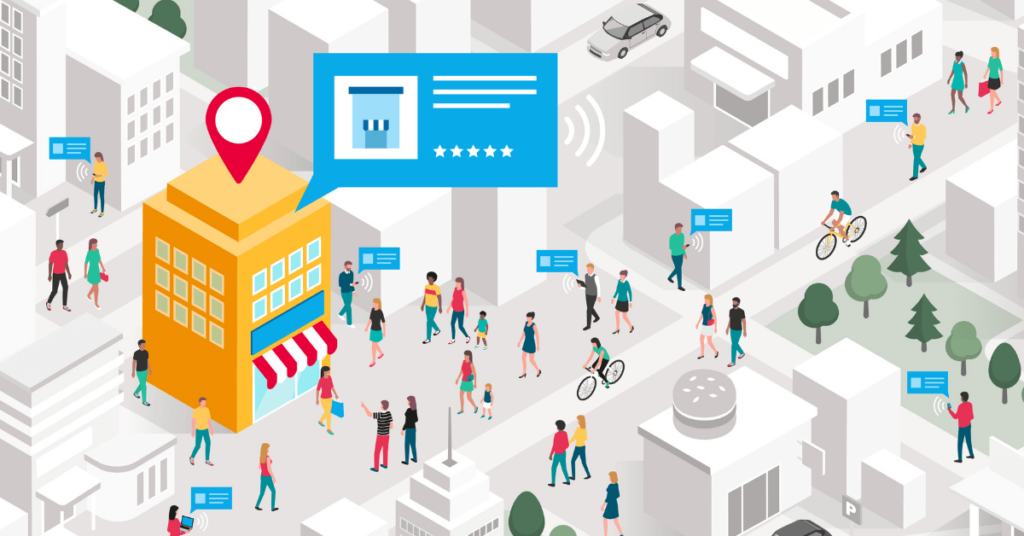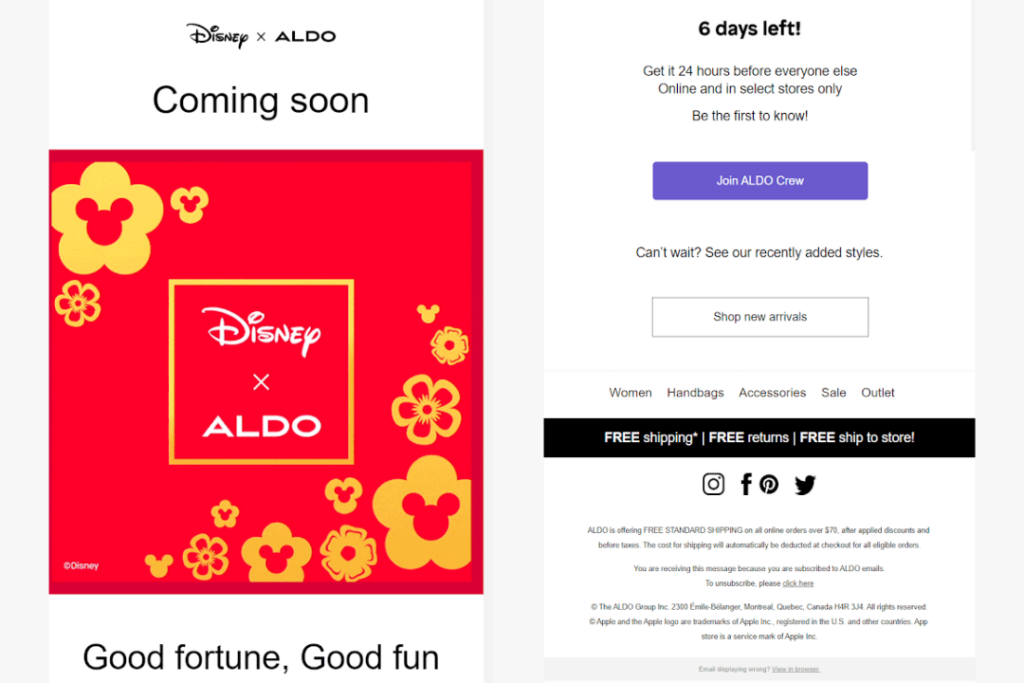

Creating a local business listing on Google — using Google Business Profile (formerly, Google My Business) — helps gain traction, more footfalls, and better brand recognition amongst your local rivals.
In fact, 78% of people go online at least once a week to look for local companies (up from 69% in 2020). Since hyperlocal businesses are a growth opportunity, going the digital route for greater visibility and better awareness can help you thrive in increasing competition.
Ideally, the first step is to build a service website (more on it soon) when creating a Google Business Profile to add credibility for prospective customers. Local prospects rely on Google to find local services with queries like “Toy shop near me”, “Dental clinic near me”, etc. A website offers them trustworthy insight into your services, business, and pricing.
With that settled, now let’s dive into eight great tips for your small business to stand out in a crowded local market.
- Build a simple yet elegant website
- Focus on local SEO and your Google Business Profile
- Use organic marketing tactics
- Collaborate with local micro-influencers and bloggers
- Create Instagram reels consistently
- Join forces with complementary service providers
- Host and participate in local events
- Try paid ads on Google and Instagram
#1. Build a simple yet elegant website
As mentioned earlier, a professional website gives you a pervasive presence on the internet. Use it as a platform to communicate with existing and potential clients.
These days, building a website does not need you to spend hours or incur a high cost. Instead, choose from many website builders that offer pre-made, ready-to-customize templates.
Crafting a brilliant website would need content that appeals to the target audience. Include search terms relevant to your company or industry to reach the right people. Here, think of local Search Engine Optimization (SEO) tactics for your small business website to rise above the rest in Google search results…
#2. Focus on local SEO and your Google Business Profile
Your local business needs local SEO for people to find you online within your vicinity. For this, begin with the hyperlocal SEO recommendations.
Besides following best SEO practices, ensure your website provides an excellent mobile experience with AMP (Accelerated Mobile Pages). For SEO, try leveraging free keyword research tools like Google Trends, Google Ads, Wordtracker, Moz, etc.
You can deep dive into local SEO ranking factors to leverage these tools better as they help you understand what local phrases you should integrate to optimize your SEO strategy. In turn, this drives more visitors to your site.
The best way to increase your visibility online is to create and optimize your Google Business Profile in line with your on-site SEO. This page helps you rank better in local search, increase site traffic, and appear in the 3-pack, ensuring online visibility.

Claim and improve your local business listing for an optimum internet presence. Provide prospective consumers with legit reviews, contact details, working hours, business address, website link, list of services, etc.
#3. Use organic marketing tactics
Organic marketing can work wonders if you are looking for ways to promote your local business. Drive more visitors to your website and stores by connecting with them meaningfully. This means you would need to align a few activities.
Send emails for product updates
Send your subscribers the update emails with detailed clubbed discount offers that drive awareness and increase footfalls and website visitors.

If you’re a business with a loyal customer following, it serves you well to offer them loyalty rewards (more in it next).
Incentivize loyalty
Increasing customer interaction may help sustain loyalty, especially in a competitive space. Contacting consumers via email or phone with special offers or company news shows you care about them.
Both consumers and businesses may benefit from loyalty rewards. Roll out loyalty programs to offer discounts on subsequent purchases — such as 10% off the next bill or cash back on monthly spending.

Consider Starbucks’ loyalty card, where joining their loyalty program earns you points when placing the next order. One receives a free purchase after a set amount of stars. This helps buyers feel justified in their purchases since they’re working toward a reward.
Add personalization
If you have the customer database, try wishing them on their special occasions (birthdays and anniversaries) over an SMS, WhatsApp, or email. This creates connections amongst the existing customers by making them feel special; in turn, they value your business more.
Retargeting
First, identify the visitors (in-store or website) inclined towards buying products. They often fill up the in-store form, drop a query on the website, or subscribe to your newsletter/blog.

Reconnecting with folks who already know about it is possible. Leverage available data to show your products and services, re-engage a section of users and entice them with lucrative discounts to push sales.
#4. Collaborate with local micro-influencers and bloggers
Contact local social media influencers having a deeper reach within the small geography. Influencers in the same geographic region as your local business may include social media influencers, bloggers, product reviewers, and industry experts.
Consider these two key findings:
- When micro-influencers suggested a product, they generated 22.2 times more conversions than ordinary customers.
- Also, more than 60% of people are more willing to follow suggestions from friends, family, or influencers on social media compared to 38% from companies or brands.
Launching a micro-influencer campaign for your local business requires developing objectives and specifying the metrics (KPIs). This helps gauge performance as they ensure reaching your target demographics.

Influencers with high levels of engagement, a regular posting schedule, and a unique style or voice are good candidates for collaboration.
Therefore, choose from the list of micro-influencers in your city and ask for the influencer’s media kit. In detail, this will have their rate card, engagement schedule, and product placements.
This is not it!
You also need them to track your campaign’s performance — monitor audience engagement and measure it against KPIs you initially set. Analyze the influencer content performance when you’re working with the same micro-influencers, finding new ones, or creating alternative KPIs for such campaigns in the future.
For tracking, your influencer can use trackable links enabling you to monitor the overall performance campaign in terms of visitors, inquiries, and conversions. They may also use an automated solution like Bit.ly to create and distribute links to your influencer partners that simplify keeping track of clicks and interactions.
#5. Create Instagram reels consistently
You can reach a wider audience by creating Instagram Reels since it offers brand exposure and product awareness to small and local business owners.
Identifying the target audience for your Reels is necessary. If possible, spend some time watching popular Reels. Check out your competitors or other businesses doing Reels.
After that, set a goal for your Reel and plan how you will accomplish it.
You only have 30 seconds to amp your game in Reels format. Most successful Reels adhere to a strict three-point formula:
- For the first couple of seconds, Reels should reflect your knowledge, and viewers should get the gist of what you are trying to communicate.
- From 2 to 25 seconds, offer the audience some tactical advice or comprehensive instruction that addresses their needs.
- In the last 5 seconds, share a clear call to action that adds value to your audience. For instance, sign up for your email to get a freebie, DM within specified dates to get offers and discounts, or tag your friends to enter the giveaway contest.
Also, Reels are not there for hard sales. Instead, provide viewers with something of value — like, fashion retailers can create Reels in three different ways to wear a single piece of clothing.
For instance, if you own a spicy sauce or oil brand, share your preferred recipes — just like how CHILLI OIL ON EVERYTHING everything does. The goal is to enhance credibility, build authority, and foster audience engagement.
#6. Join forces with complementary service providers
Brand collaboration increases your visibility as you join forces with businesses that agree to offer complementary services of great discounts. For starters, go with partners who share your beliefs and aspirations. Ask them about their business, and if you learn that both confront similar issues go for the collaboration to create a win-win situation.
The complementary business should offer products that relate to yours and not compete with what you offer. They may be located under the same roof. Examples of co-located businesses include Starbucks outlets inside Barnes & Noble Bookstores or car detailing businesses inside parking garages.
Complementary businesses offer extra convenience and encourage new spending opportunities amongst local customers. And taking up this route will help both businesses to expand to the other’s market by attracting new customers.
For example, if you and your partner business can exchange product samples (for free or for a small fee), you will be able to introduce your products to a new set of audiences. And, you have an advantage when recommending the complementary business to customers as your suggestion carries extra weight as they trust your business.
#7. Host and participate in local events
Indulging in some on-field, traditional marketing won’t hurt when building visibility for your local business. Consider getting your business noticed in your area by sponsoring or organizing a local event here. One way involves getting the attention of local media (newspapers, hoardings, magazines, etc.) by advertising this event.
Small businesses face challenges in getting their products and services in front of more people. Such events can help conventionally gain traction. You can host events like fairs, festivals, and conferences that help draw more customers.
Organizing such events can:
Boost visibility: Host and sponsors get free promotion as visitors photograph their experience and publish it on social media. This puts your brand in front of new audiences when consumers write about their experiences from the event.
Aids business partnerships: A branded event is not just about hosting. The host may partner with non-competing businesses (like yours) for offline events to share the event’s expenses and marketing possibilities. This strategy can develop into long-lasting partnerships that can turn into collaborations on digital platforms (as discussed earlier).
Turn attendees into hot leads: Leverage the guest list for an upcoming event as attendees offer their contact information while registering for free events or purchasing paid tickets. In the future, you can use that data to keep in touch with this set of audiences (who have previously shown interest) and tailor offers and discounts that drive more sales.
#8. Try paid ads on Google and Instagram
You can go for the Google Shopping campaign when selling products which offers a faster and more effective way to sell your products online. And, if you are into the service business (Saloon, Spas, Restaurant), think of leveraging hyper-local Google Ads that allow accurate location targeting.
Product-based businesses: Getting orders to your shop using Google Ads is possible as it reaches folks who are already interested in your product.

For instance, if you sell crockeries, target the audience searching for “crockery store near me” or “buy tea mugs” with your ad.
Service business: Use Local Services Ads directly from your Google Business Profile as you will only pay for the leads interested in your business’s offerings (on pay per click basis). Suppose you want to target an audience in your service region.

In that case, these advertisements offer a terrific alternative as Google also requires visitors to validate their location for the service they’re looking for before redirecting them to you.
On the other end, you have Instagram Ads integrated with Facebook Ad Manager. Your business can leverage Facebook’s vast user data to reach the intended audience with targeted ads.
In fact, 75% of users will act after viewing an ad on Instagram. This means they will either inquire about the product or visit the website.
Note that your Instagram ad’s cost will be tailored to your requirements. For starters, a typical cost-per-click for Instagram advertising is between $0.70-$0.80.
When starting with this platform, note that there are five key ways to create and manage Instagram ads:
- Within Instagram
- Facebook’s Marketing API
- Facebook Ads Manager
- Instagram Partners
- Power Editor
Also, choose from various types of ads that you can run on Instagram:
- Photo Adverts
- Carousel Adverts
- Stories Adverts
- Video Adverts
A typical Instagram Ad journey for your small business would include the following:
Choose the post you want to promote
When promoting a post, seek pieces that have received a lot of likes and comments from their organic audience. If possible, create a powerful post that speaks about your business, and give lucrative offers on sign-ups and new followers to gain traction. This will depend on your ad objective.
Choose An Ad Objective
A typically paid ad on Instagram would have any of the following intents:
- Increasing followers by improving profile visits
- Drive traffic on the website to build brand awareness and drive sales.
- Reach people in the neighbourhood to drive more in-store footfalls.
Set up Ad with CTA, Budget, and Duration
Create a CTA for the ad depending on your ad purpose. For instance, choose “Learn More” if you want users to jump on your website, “Watch More” to view a longer video, “Shop Now” to make a purchase immediately, etc.
Enter your URL, address, or phone number depending on your ad campaign’s goal. You can also target by geography, gender, age, and hobbies.

Also, drive in-store traffic by targeting specific areas for your adverts. You will need to include the total budget and the number of days you want to run an ad for.

Evaluate ad performance
At this point, you must evaluate the success of your campaign. The Facebook Ads Manager reporting table will have results for your Instagram ads.
Check your Ad metrics by:
- Navigating to Ads Manager.
- Choose the campaign name.
- Click “view charts.”
Check for Performance, Demographics, and Placement statistics at the top of the page. Depending on your ad goal, you can check several performance metrics such as the amount spent and cost per result to evaluate the campaign’s ROI.
Over to you
Getting and updating your Google Business Profile is a good starting point for this journey. Local businesses can leverage their presence, especially if they have a store or restaurant. Improving your business visibility requires more than just the factors mentioned above; you can start with anyone. Your local business aims to offer precise location and show your availability, product or service, and prices on the internet.
Adopting these tips can put you ahead of the curve in your local market. Try leveraging a mix of website development, Instagram and Facebook, offline events, and micro-influencers for the best possible outcome.
Subscribe to stay ahead with the latest updates and entrepreneurial insights!

Subscribe to our newsletter
Get access to the latest industry & product insights.




























